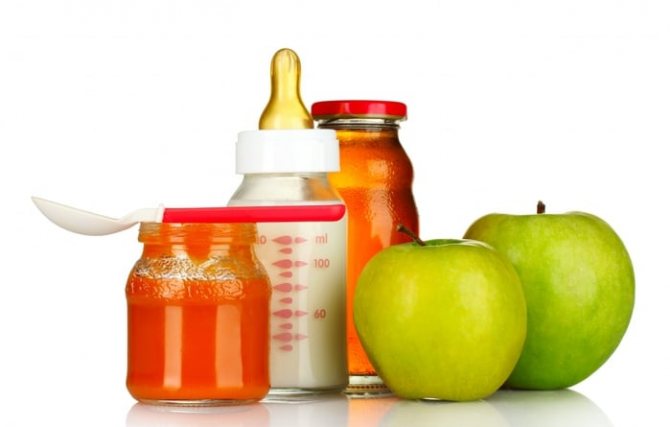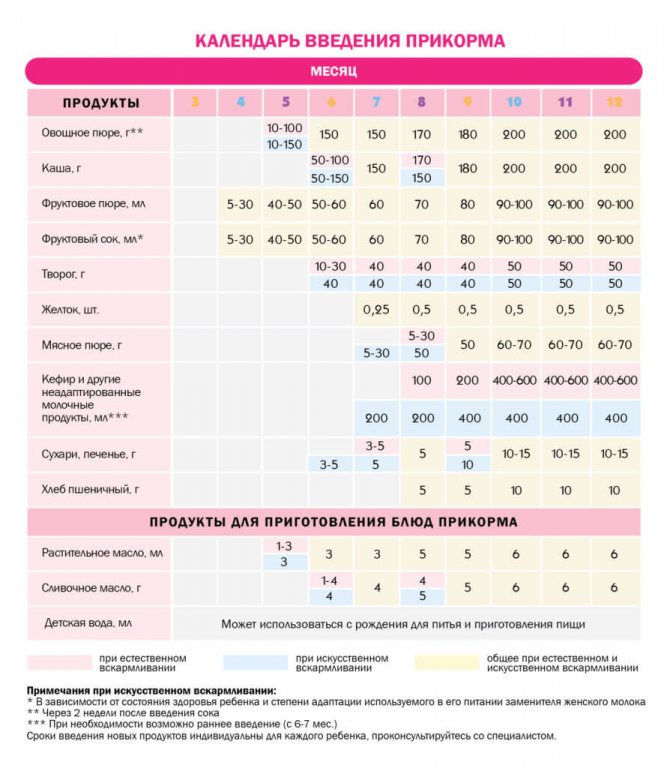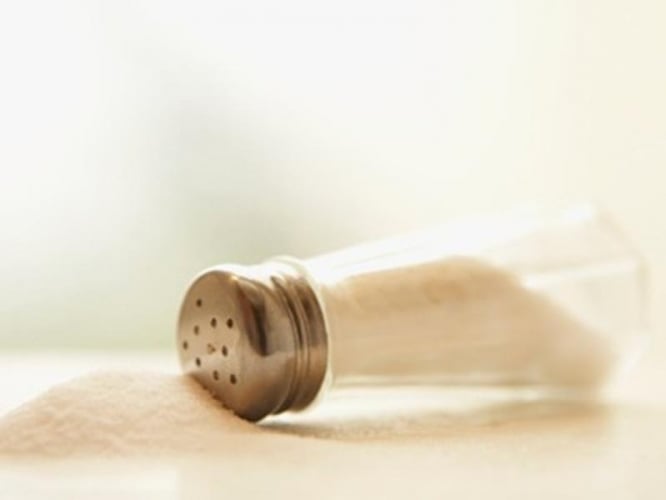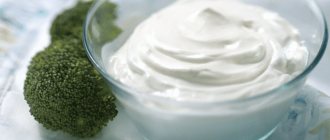Child nutrition: new foods in the diet
A 7-month-old baby's primary source of nutrition should still be breast milk or infant formula. You can diversify your baby's diet with children's fruit, vegetable, meat purees, dairy and non-dairy porridges, and children's juices. You can also slowly introduce some “adult” foods into your baby’s diet at this age.
So, let’s look at what can be included in a child’s diet at 7 months:
- porridge. It is also important to administer porridge along with breast milk. Make milk-based or dairy-free cereals; it is preferable to choose gluten-free cereals with a high iron content, for example, rice, buckwheat, oatmeal, then you can add corn and semolina porridge. Start feeding porridge with 1 teaspoon, gradually increasing the baby's portion to 150 grams;
- specialized children's nutrition. Fruit and vegetable purees also significantly diversify the baby’s menu at 7 months. To start, choose one-ingredient vegetable purees that do not cause allergies, such as potatoes, zucchini, cauliflower, and broccoli. Then, if the baby does not have allergies, you can introduce carrot, tomato, and pumpkin puree into the diet. After your baby has become familiar with vegetable purees, introduce fruit purees to his menu. Also, the choice should be made in favor of non-allergenic fruits, such as banana, apple, pear. Also introduce gradually, starting with one teaspoon, increasing the portion to 150 grams;
- meat products. At this age, you can begin to accustom your child to eating meat products. The choice should be made in favor of light, dietary types, such as chicken, rabbit, turkey, veal. Carefully read the composition of the product and make sure that this type of baby food is appropriate for the age of your baby. Meat is rich in protein, and it, in turn, is necessary for a growing, developing body, so you should not exclude meat products. Also start giving your child little by little, and if there are no negative reactions of the baby’s body to this or that type of meat, you can increase the portion to 60 grams;
- juices You can add variety to your baby's menu by adding juices. It is preferable to start by giving your baby clarified juice from apples or pears, and then gradually introducing new flavors. Choose juices from the baby food line because they do not contain sugar or other undesirable elements for your baby. It is unacceptable to give regular packaged juices “for adults”; they can be consumed no earlier than 3 years of age. It is important to introduce juices into your baby’s menu after you have accustomed your baby to cereals, vegetable purees and meat, because if you first give your child juice, he may later refuse the above-mentioned products because of their less vibrant taste;
- egg yolk. In addition to cereals and vegetable purees, egg yolk can be introduced at the age of 7 months. Just don’t be confused, you only need to give the yolk, since it is an excellent source of healthy omega-3 fats, selenium, etc. To begin with, like all other complementary foods, the product needs to be “tested” so that the baby does not have an allergy, and only after making sure In the normal reaction of the body to egg yolk, it can be introduced not as a separate product, but as an additive to cereals and purees. In addition to chicken yolk, you can try giving your child the yolk of quail eggs;
- children's cookies and crackers. At this age, some babies begin to cut their teeth, so you can introduce baby crackers and cookies into the diet, just choose a product that is not too hard so that the baby does not cut his gums and get hurt. Also carefully study the composition so that it does not contain synthetic elements that are harmful to the child’s body. The important thing is that the baby should eat solid food while sitting and strictly under adult supervision.
When your baby is used to pureed foods, you should give him more solid foods. Check out the texture options for complementary foods in the diagram below.
What to feed a baby at seven months
Experts have compiled a sample menu of dishes for a seven-month-old baby. These babies can be given:
- Buckwheat, corn and rice porridge with water. If tolerated normally, oatmeal can be given;
- Soups and purees made from light-colored chopped vegetables. Zucchini, cauliflower or broccoli and potatoes are good complementary foods. If the baby does not have allergies, you can give carrots, pumpkin and greens;
- Fruit puree. We make it from apples and pears, bananas and apricots. Avoid citrus fruits and exotic fruits (except bananas);
- Dairy and fermented milk products. This is low-fat cottage cheese and yogurt, children's kefir. Remember that products must be without additives!;
- Boiled egg yolks;
- You can add butter and vegetable oil to vegetable dishes and cereals;
- At seven months they begin to introduce meat. This is lean boiled beef or veal, chicken or turkey, rabbit. The meat is thoroughly chopped and added to vegetable soup or puree.
When starting complementary feeding, do not give up breastfeeding. Doctors recommend starting the first morning feeding with breast milk. Also supplement your baby with formula milk if he is on mixed or artificial mixed feeding.
Alternate between home-cooked meals and ready-made purees of vegetables or meat. The composition of such purees is balanced and suitable for babies. However, when choosing, carefully study the packaging. Pay attention to the composition, date of manufacture and expiration date, as well as for what age the product is intended.

Daily diet
It is very important to develop a child’s diet at 7 months so that the baby gets used to this routine and you do not have problems with it in the future. But if the baby refuses food, you should not force him to eat; it is better to feed him more nourishingly at the next meal. Make a weekly menu schedule for your baby, stick to it, and build an individual diet. If possible, you can consult your pediatrician. Make changes to the menu as necessary, replace some products with others if the baby refuses something.
Breastfed
The table shows the approximate daily diet of a breastfed baby by the hour.
| Feeding time | Menu | Serving Size |
| Meal 1: 6:00 | 1) breast milk; | 1) 200 ml; |
| Meal 2: 10:00 | 1) dairy-free or milk porridge; | 1) 150 gr. |
| 2) butter; | 2) ½ tsp. | |
| 3) egg yolk; | 3) ¼ tsp. | |
| 4) breast milk; | 4) 50 gr. | |
| Meal 3: 14:00 | 1) fruit puree: | 1) 170 gr. |
| 2) vegetable oil; | 2) 1 tsp. | |
| 3) meat puree; | 3) 30 gr. | |
| 4) fruit children's juice; | 4) 70 gr. | |
| Meal 4: 18:00 | 1) vegetable puree; | 1) 70 gr. |
| 2) children's cookies or crackers; | 2) 1-2 pcs. | |
| 3) breast milk; | 3) 130 gr. | |
| 5th meal: 22:00 | 1) breast milk; | 1) 200 gr. |
Artificially fed
The diet of a bottle-fed baby is not very different, but you can also look at it in detail in the table below.
| Feeding time | Menu | Serving Size |
| Meal 1: 6:00 | 1) infant formula; | 1) 200 ml; |
| Meal 2: 10:00 | 1) dairy-free or milk porridge; | 1) 150 gr. |
| 2) butter; | 2) ½ tsp. | |
| 3) egg yolk; | 3) ¼ tsp. | |
| 4) infant formula; | 4) 50 gr. | |
| Meal 3: 14:00 | 1) vegetable puree: | 1) 170 gr. |
| 2) vegetable oil; | 2) 1 tsp. | |
| 3) meat puree; | 3) 30 gr. | |
| 4) fruit juice; | 4) 70 gr. | |
| Meal 4: 18:00 | 1) fruit puree; | 1) 70 gr. |
| 2) children's cookies or crackers; | 2) 1-2 pcs. | |
| 3) infant formula; | 3) 130 gr. | |
| 5th meal: 22:00 | 1) infant formula; | 1) 200 gr. |
How much should a baby eat
At 7 months, the baby should eat an amount of food per day that is 1/8 of his body weight, excluding juices, tea, compotes, and water. Drinks are not included in this figure. On average, this comes out to 1000-1200 grams of food. Divide this gram into 5 meals, it turns out that on average a baby should eat about 200 grams of food per 1 meal. This regimen will have a beneficial effect on the baby’s digestion, and he will not be bothered by a sore tummy.
It is important to feed the baby with breast milk (or formula) in the morning, a few hours later - a second meal, which already consists of complementary foods, then lunch, dinner, and before bedtime the baby can again be fed with formula or breast milk. The last meal before bed should be lighter than the previous ones so that the child's sleep is calm and comfortable.
For convenience, it is better to create a complementary feeding calendar.

Sample daily menu for a 7 month old baby
Let's consider the menu for a seven-month-old baby for every day:
- after waking up: breast milk or infant formula, depending on whether the baby is breastfed or bottle-fed - 150 - 200 g;
- for breakfast around 10:00: porridge – 150 g; fruit baby puree – 70 g;
- for lunch around 14:00: vegetable puree or homemade broth with meat and vegetables - about 180 g; you can add 1 tsp to puree or soup. oils; 1/4 pureed egg yolk; baby juice or fruit puree - 30 g;
- for an afternoon snack around 18:00: porridge - 50 g; children's cottage cheese – 30 gr.; juice or fruit puree - 30 g; cookies - 1-2 pcs.;
- before bedtime: breast milk or infant formula – 200 g.
Diet for seven months per week
An important point when introducing a new menu is the number of servings per week. After all, an overabundance of new food can lead to big problems. The table will tell you how many times what foods should be given to your baby.
| Products | Number of servings per week | One serving |
| Breast milk or formula | 7 | 100-200 grams |
| Vegetable puree | 7 | 100-200 grams |
| Juice/compote | 7 | 50-100 grams |
| Cottage cheese | 2-3 | 30-50 grams |
| Kefir/yogurt | 2-3 | 100-200 grams |
| Meat/ripple | 2 | 20-50 grams |
| Porridge | 7 | 100-200 grams |
| Egg yolk | 2 | ¼-½ teaspoon |
| Vegetable oil/butter | 7 | 5-10 grams |
Remember about the individual development of each baby. Be sure to monitor your child’s reaction and well-being, because some foods can cause stomach upset, allergies, and even poisoning!

Feeding recommendations
The main thing to remember is that everything is purely individual. Just because your friend's child eats one thing doesn't mean your child should eat the same thing. The main rule is to adhere to the diet, some deviations are possible, because a child is a person, he may also have his own needs, he may have no appetite, you do not have to follow all the laws and rules, like in the army. But it’s also wrong to treat your baby’s nutrition with chaotic indifference. If you feel that something is wrong, it is better to contact your pediatrician.
Here are some basic recommendations:
- at this age, start introducing complementary foods, diversify the menu of a 7-month-old child with new foods;
- add solid food, cut into small cubes, to the diet so that the child learns to chew and gets used to “adult” foods;
- give preference to steaming, stewing or boiling, but do not fry;
- 1 baby meal should weigh approximately 200 grams, excluding drinks, and there are 5 meals in total, so it turns out that the baby will eat approximately 1000 grams of food per day;
- do not force your baby to eat, if he doesn’t want to eat now, he will want to in a couple of hours;
- analyze which products your child does not like and he refuses them, find alternative options with which this product can be replaced;
- The first meal after waking up and the last meal before bed should be significantly lighter than the others, as a rule, this is breast milk or infant formula in the amount of 200 grams. This regime will ensure comfortable digestion for the baby and peace of mind for the mother;
- use bright dishes with images of cartoon characters to color your baby’s meal, perhaps this will help if the child refuses to eat;
- When introducing a new dish into your child’s diet, add only one new product to it. You need to introduce your child to complementary foods in stages, and introduce each new ingredient little by little and in small doses, and not in mixed form, in order to monitor the baby’s body’s reaction specifically to the product;
- It is not recommended to give your baby water to drink while eating, only before and after meals. This recommendation concerns drinking water, not juices and compotes (they should be offered to the baby after every meal). It is better to give liquid structures in a sippy cup;
- Prepare homogeneous dishes for your baby. To do this, it will not be enough to simply mash the product with a fork; it is better to beat it with a blender so that there are no clots or lumps left, and then additionally pass it through a sieve;
- Pay attention to how your child eats and what he eats. Under no circumstances allow you to eat while lying down, it is unsafe. Only sitting and preferably in a special highchair. It is recommended to use a spoon made of certified plastic;
- It is better to introduce a new product into a child’s diet during the daytime, for lunch. By this time, the body has already “woke up” and is ready to take new food, and the mother will have the opportunity to track the baby’s reaction to this or that product until the evening;
Baby menu at 7 months
Many mothers ask the question: “What to feed a baby at 7 months?” The answer to this question can be obtained by studying a detailed approximate daily diet for breastfed and bottle-fed babies for every day.
Breast-feeding
Breast milk is the most useful nutritional element for a baby at this age, because the child is growing, the body must be strong and healthy, and mother’s milk contains all the necessary vitamins and minerals for the child’s health. Therefore, if possible, do not refuse to feed your baby, because no artificial milk formula can replace mother’s milk.
So, let's look at the menu for a 7-month-old baby every day. The meal after waking up and before going to bed is breast milk in an amount of approximately 200 grams. Let's look at what to feed a 7-month-old baby, an approximate menu for every day of the week.
Monday
- Breakfast: semolina porridge with pieces of fruit (150 g), cottage cheese with fruit (50 g), pear puree (50 g);
- Lunch: vegetable puree from broccoli or pumpkin (180 gr.), rabbit meat puree (70 gr.), 1/4 egg yolk, compote or baby juice without sugar (150 gr.), 1 slice of bread;
- Afternoon snack: homemade yogurt (100 gr.), buckwheat porridge (50 gr.), pear puree (50 gr.), children's cookies (1-2 pcs.).
Tuesday
- Breakfast: buckwheat porridge with zucchini (100 g), baby plum puree (50 g r.), baby cottage cheese without sugar (50 g r.);
- Lunch: soup with meatballs made from turkey meat, cabbage and potatoes with onions, carrots, herbs (200 gr.), apple and peach puree (50 gr.), 1 slice of bread;
- Afternoon snack: children's fermented baked milk (100 g), oatmeal (100 g), ½ baked apple.
Wednesday
- Breakfast: rice porridge (100 gr.), jelly (50 gr.), soft baby cottage cheese (50 gr.);
- Lunch: vegetable soup, pumpkin-zucchini (200 gr.), fish meatballs (50 gr.), children's fruit juice without sugar (50 gr.), 1 slice of bread;
- Afternoon snack: homemade yogurt (berries + kefir) (100 g), corn porridge with fruit (100 g), children's cookies.
Thursday
- Breakfast: oatmeal with berries (100 gr.), children's cottage cheese with pieces of fruit (50 gr.), chopped plums;
- Lunch: vegetable and meat puree from broccoli and turkey (200 gr.), applesauce (50 gr.), fruit juice without sugar for children (80 gr.), 1 slice of bread;
- Afternoon snack: children's fermented baked milk, buckwheat porridge (100 g), children's cookies 1-2 pcs.
Friday
- Breakfast: corn porridge with apple (100 gr.), children's cottage cheese (50 gr.), plum puree (50 gr.);
- Lunch: chicken soup with rice, carrots and onions (200 g), baby pear puree (50 g), dried fruit compote (70 g), 1 slice of bread;
- Afternoon snack: homemade yogurt made from kefir and berries (150 gr.), children's cookies (1-2 pcs.), wheat porridge (100 gr.).
Saturday
- Breakfast: buckwheat porridge with pieces of fruit (100 g), children's cottage cheese (50 g), children's fruit juice without sugar;
- Lunch: puree of pumpkin, carrots, rabbit meat (200 g), baked apple with berries, 1 slice of bread;
- Afternoon snack: children's kefir (150 g), crackers or cookies 1 piece, corn porridge (100 g), pear puree (50 g).
Sunday
- Breakfast: wheat porridge with pumpkin (100 g), children's cottage cheese with berries (50 g), berry jelly;
- Lunch: beetroot soup (180 gr.), chopped low-fat fish (50 gr.), fruit puree from apple and peach (50 gr.), dried fruit compote without added sugar (100 gr.);
- Afternoon snack: yoghurt with apple sauce (150 g), children's cookies 1-2 pcs., barley porridge (100 g).
Artificial feeding
Try to feed your baby strictly by the hour, according to the schedule. This will be better for his body, and mom will be able to plan her day without any hitches. Make and write down a menu for a 7-month-old bottle-fed baby for a week.
Attach this sheet with the written diet in a visible place, so you won’t get confused about what to cook and when. The child's breakfast will be standard - infant formula, as well as a late dinner, which will take place immediately before bedtime.
Let's look at a sample menu for a 7-month-old baby for every day.
Monday
- For breakfast at 10:00 - 150 g of rice porridge, peach and apple puree.
- For lunch, offer your child soup with meat broth, 30 g of finely chopped chicken, and plum puree.
- Afternoon snack – cottage cheese, barley porridge, cauliflower puree.
Tuesday
- On Tuesday, for second breakfast, serve corn porridge, a little stewed zucchini and cabbage.
- At 14:00 lunch consisting of vegetable cream soup, cottage cheese and prunes.
- The afternoon snack can be varied with children's cookies and fermented baked milk.
Wednesday
- Wednesday can start with buckwheat porridge and broccoli puree.
- For lunch, offer your baby vegetable soup made from cabbage and beets, and some baby cottage cheese.
- A hearty dinner of pureed meat and fruit juice will be helpful.
Thursday
- For breakfast, continue to introduce your child to porridge, rice porridge and carrot and beet puree.
- The baby will like a hearty lunch consisting of meat broth, vegetables, chopped in a blender and cookies.
- For an afternoon snack, offer fruit puree with kefir.
Friday
- For breakfast, wheat porridge, pear puree.
- Lunch of meatballs and potatoes.
- For an afternoon snack, baby cottage cheese and 1/4 egg yolk.
- For dinner, puree any fruit, some rabbit meat stewed with zucchini.
Saturday
The weekend menu may consist of your child’s favorite dishes. But don’t overuse it, remember that a regime is a regime.
Meat dishes
From seven months, meat can be introduced into the baby's menu when breastfeeding. Choose fresh, lean meat without additives. You cannot use frozen product or ready-made minced meat. The baby is given either puree soup with meat broth or puree with added meat.
Take beef, veal, rabbit, turkey or chicken. The piece is cleaned and the veins, skin and bones are removed. You can simply prepare broth using meat, to which you then add chopped vegetables. You can also chop the cooked meat and add it directly to the vegetable puree.
It is not recommended to give a meat dish to infants more than twice a week. In the future, meat is alternated with fish. Fish is allowed to be introduced into the menu after 10-11 months.












